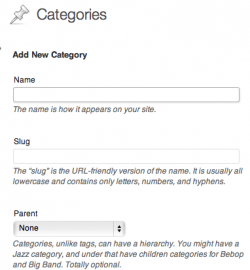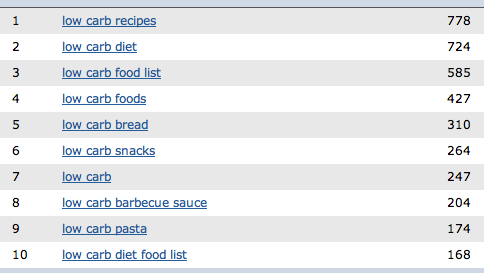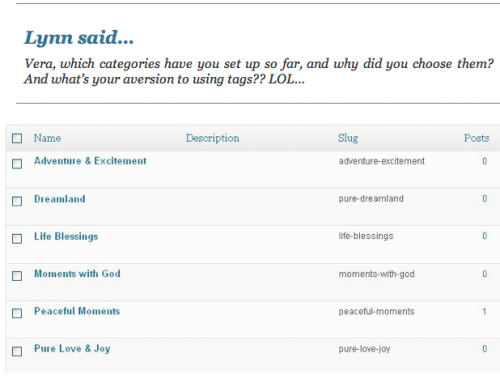
Today we'll look at how to set up WordPress Categories, and the best use of Tags in your blog posts, using Vera's new blog as an example.
You'll learn common mistakes with Tags and Categories, how to fix them (or how to improve yours!), and the proper way to use Keywords.
This has actually been a VERY popular topic in my Private Mastermind Group lately, so I think you'll really enjoy this helpful tutorial...
Overview: Categories and Tags
WordPress Categories are used for the general topics you'll cover on your blog.
WordPress Tags are used for micro-topics within those general categories.
Both of these are used as Navigation on your blog, and so they're highly important factors in your overall site usability. Meaning, they will help visitors (and encourage them to) click deeper into your site, stay on your site longer, and improve your potential to turn a visitor into a subscriber - and loyal reader.
All very important goals. 😉
The more pages someone visits when they land on your blog, and the longer they stay actively engaged with your blog, the more the search engines view your site as a valuable resource. This also lowers your bounce rate, of course. Good SEO stuff.
Again, Categories are for general topics (think: site navigation), Tags are for micro-topics (highly specific keywords that connect related content).
Using Keywords In Your Categories and Tags
Contrary to popular belief (or inaccurate teachings), WordPress Tags are not meant to be used as "keyword stuffing" in your blog posts. While you do want to use Keywords and Keyword Phrases, there is a right and a wrong way to do it...
We'll start with Categories. I'll discuss Tags in a minute.
Consider the topic of your blog. This is the most general "topic" of your entire site structure. For example, with TravelingLowCarb.com my topic is low carb. If you type that into WordTracker's Free Keyword Research Tool (ref) you'll get general topics - or keyword phrases - related to low carb:
You want to use keyword phrases as your Categories because these phrases are your market's language. It's how they search, what they search for, and their general interests on your overall topic. Make sense? 🙂
Note: You may want to set up Pages for certain keyword phrases on your blog, instead of Categories. This is best used for Evergreen Content that is useful to first-time visitors or people new to your topic. Another example is if it's not a topic you'll be blogging on regularly, but is useful as part of your site navigation. You can see an example of this on my blog at TravelingLowCarb.com
Both Pages and Categories are part of your Site Navigation. Use general topics (and general keyword phrases) for both. You'll target more specific (longtail) keyword phrases in your actual blog posts.
Just to recap, Pages and Categories are your general topics. Blog posts are the subtopics. Tags are micro-topics that connect related sub-topics.
How To: WordPress Categories
First, only categories that actually have posts in them will show up on your blog. So if you've created categories and they're not showing up in the list on your blog, it's simply because they don't have any posts in them yet.
Second, you can always create new categories on the fly, so don't stress about choosing them all and getting them set up before you start blogging.
Here is a detailed tutorial on How To: WordPress Categories.
There are two main fields when setting up a Category: the Category Name, and the Category Slug. The "Name" is simply the name of the category as it will appear on your site. The "Slug" is part of the link for that category:
You want to set up your "slugs" so that they make a nice, clean URL (link). That way people know exactly what to expect before clicking on that link. Example:
travelinglowcarb.com/category/low-carb-foods/
Note About Changing Your Current Categories...
If you decide you want to change your "site navigation", or your WordPress Categories, a word of caution: don't edit your current categories. Changing the "Slug" will create a lot of broken links across your blog. Especially if your category name shows up in the URL (link) of individual blog posts.
On my blog, it doesn't. I simply include the Post ID in the URL.
Example: travelinglowcarb.com/3892/zucchini-pasta/
So if I wanted to change my Category Names, here's what I would do:
I would create the new Category with the name and slug I want. Then assign all of the related posts to that Category by editing the post, changing the category selection, then updating that post.
Once all posts have been "moved" out of the old Category and into the new one, the original Category will no longer show up on your blog or in your navigation.
The search engines will index your new categories, and if you delete your original categories then those links will ultimately drop out of the search results. This is a minimal change considering it ONLY affects Category pages - again, assuming you don't have the Category Name as part of your blog post URL's.
Using Tags To Connect Related Blog Posts
The purpose of tags is to interlink related content on your blog, and to make it easier for your visitors and readers to find very specific information.
As an example, I discuss "low carb restaurants" a lot on my blog since I travel (and eat out) a lot. I might choose different low carb menu items from the same restaurant on different visits, so I use Tags here to connect all the posts that mention a specific restaurant: travelinglowcarb.com/tag/macaroni-grill/
On Angie's weight loss and fitness blog, you might notice a recent post about the health benefits of blueberries. Let's say you have a whole batch of blueberries and you're looking for good recipes for them. This is where the Tag comes in handy:
losingitandlovingit.com/blog/tag/blueberries/
Again, a Tag is a micro-topic that may be covered in more than one category.
The general rule of thumb for using Tags:
If it doesn't make sense to your readers, don't "tag it".
Tagging is not a means of "keyword stuffing" your blog posts. If it doesn't help your visitors and readers navigate your site better, it's useless. Period.
Use tags to connect highly related content on the micro level to make your blog easier (and more fun!) to read.
Live Example: Vera's WordPress Categories
Vera is working on her site live throughout this series, which gives us a great live example so you can see practical application. In her last reply, she showed us what she'd set up so far:
Vera said: "I picked these categories because they are all things I’d like to personally enjoy along the way. I do want adventure and excitement but I also want to explore having peaceful, lovely moments.
I gather I should put in some categories like, “product reviews” or “books” to reflect my reviews on different things too."
Vera's blog is a more personal work at FaithAdventurist.com where she'll be discussing spirituality, life as a Christian, expanding your Faith through adventures, and living a more meaningful and fulfilling life.
Her categories should reflect all of that, since those are her "general topics." The categories she has set up now make more sense to HER, than they will to her readers.
Agree/Disagree?
Vera's Homework (and perhaps yours as well?):
Play around with WordTracker's Free Keyword Research Tool. Look specifically for phrases that match the general topics you'll be discussing at your blog. Start by typing in a general word, such as "Faith" - you'll find things like: women of faith, leap of faith, blind faith, walk by faith, hope and faith.
My advice: Vera should have a category titled "Hope and Faith" with the slug "hope-and-faith". This is a topic she'll be covering a lot, and it's exactly what her target market is searching for.
Vera: Do keyword research, and share what you come up with. You'll likely find a lot of blog post ideas while you're browsing keyword phrases, too. 😉
In our next post, we'll talk more about Keyword Targeting and how/where to use all the cool Keyword Phrases you come up with in your "quick research" session. 😀
Best,












I'm not that knowledgeable about WordPress Categories so I find this post really good at explaining on how to use it. I am also pretty sure a lot of newbies will find this post helpful. Thanks for the free education! 🙂
I'm glad you found it helpful, Riza! If you have any questions along the way, just let me know. 😉
Nice post. I like Vera's homework part. I usually choose my tags when I have new posts to submit. I should have planned in advanced right when I started the blog, and wrote according to the tabs instead.
There's always new things to learn. Thanks!
It's tough to know all the tags you might use at the very beginning. It's really a work in progress, making sure micro-topics are connected via Tags. 😉
I'm still confused about the tags.
I don't actually list the tags on the bottom of my posts or anywhere a visitor can actually see them. Only the categories show for visitors.
So, in this case how do tags actually help with site navigation?
I really did believe all these years that tags were for keywords.....oh my.
Interesting - it sounds like they just aren't included anywhere in your theme. You can certainly add them in if you want to use them... Which theme are you using?
I took them out so that they don't show on the bottom of each post. I don't see a list of tags on the bottom of your posts here, just categories.
I see on a lot of blogs that tags are not listed and so I removed them from being visible as well.
I use Tags, I just didn't use any in this particular post. It can be hard to keep them organized, which is why it's the Elite Challenge in my private group this month. 😉 But I do use them. You can see my Tag Cloud on the Archives page in the top navigation. And if I use them on a post, they show up at the end near the Categories.
If you took them out, and don't use them, honestly it's not a big deal.
I do use tags when I write my posts. They are just not visible to the reader.
Thanks for the clarification. I can always make them visible again.
Lynn, found this post to be very useful and what I needed. I have made it more accessible to go back to when needed.
Thanks for sharing
Linda T.